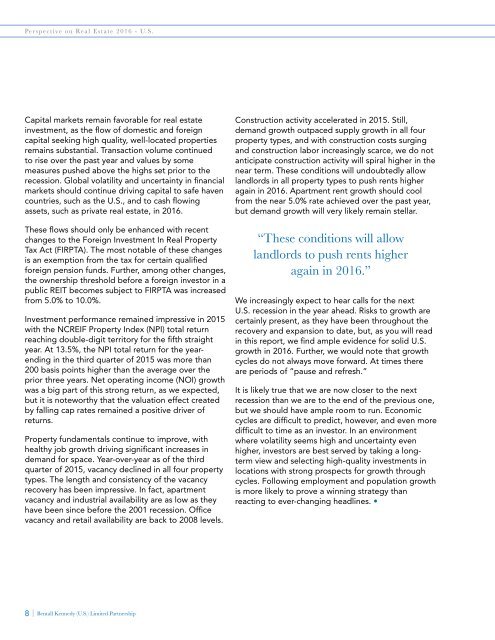BK Perspective Real Estate USA 2016
You also want an ePaper? Increase the reach of your titles
YUMPU automatically turns print PDFs into web optimized ePapers that Google loves.
<strong>Perspective</strong> on <strong>Real</strong> <strong>Estate</strong> <strong>2016</strong> - U.S.<br />
Capital markets remain favorable for real estate<br />
investment, as the flow of domestic and foreign<br />
capital seeking high quality, well-located properties<br />
remains substantial. Transaction volume continued<br />
to rise over the past year and values by some<br />
measures pushed above the highs set prior to the<br />
recession. Global volatility and uncertainty in financial<br />
markets should continue driving capital to safe haven<br />
countries, such as the U.S., and to cash flowing<br />
assets, such as private real estate, in <strong>2016</strong>.<br />
These flows should only be enhanced with recent<br />
changes to the Foreign Investment In <strong>Real</strong> Property<br />
Tax Act (FIRPTA). The most notable of these changes<br />
is an exemption from the tax for certain qualified<br />
foreign pension funds. Further, among other changes,<br />
the ownership threshold before a foreign investor in a<br />
public REIT becomes subject to FIRPTA was increased<br />
from 5.0% to 10.0%.<br />
Investment performance remained impressive in 2015<br />
with the NCREIF Property Index (NPI) total return<br />
reaching double-digit territory for the fifth straight<br />
year. At 13.5%, the NPI total return for the yearending<br />
in the third quarter of 2015 was more than<br />
200 basis points higher than the average over the<br />
prior three years. Net operating income (NOI) growth<br />
was a big part of this strong return, as we expected,<br />
but it is noteworthy that the valuation effect created<br />
by falling cap rates remained a positive driver of<br />
returns.<br />
Property fundamentals continue to improve, with<br />
healthy job growth driving significant increases in<br />
demand for space. Year-over-year as of the third<br />
quarter of 2015, vacancy declined in all four property<br />
types. The length and consistency of the vacancy<br />
recovery has been impressive. In fact, apartment<br />
vacancy and industrial availability are as low as they<br />
have been since before the 2001 recession. Office<br />
vacancy and retail availability are back to 2008 levels.<br />
Construction activity accelerated in 2015. Still,<br />
demand growth outpaced supply growth in all four<br />
property types, and with construction costs surging<br />
and construction labor increasingly scarce, we do not<br />
anticipate construction activity will spiral higher in the<br />
near term. These conditions will undoubtedly allow<br />
landlords in all property types to push rents higher<br />
again in <strong>2016</strong>. Apartment rent growth should cool<br />
from the near 5.0% rate achieved over the past year,<br />
but demand growth will very likely remain stellar.<br />
“These conditions will allow<br />
landlords to push rents higher<br />
again in <strong>2016</strong>.”<br />
We increasingly expect to hear calls for the next<br />
U.S. recession in the year ahead. Risks to growth are<br />
certainly present, as they have been throughout the<br />
recovery and expansion to date, but, as you will read<br />
in this report, we find ample evidence for solid U.S.<br />
growth in <strong>2016</strong>. Further, we would note that growth<br />
cycles do not always move forward. At times there<br />
are periods of “pause and refresh.”<br />
It is likely true that we are now closer to the next<br />
recession than we are to the end of the previous one,<br />
but we should have ample room to run. Economic<br />
cycles are difficult to predict, however, and even more<br />
difficult to time as an investor. In an environment<br />
where volatility seems high and uncertainty even<br />
higher, investors are best served by taking a longterm<br />
view and selecting high-quality investments in<br />
locations with strong prospects for growth through<br />
cycles. Following employment and population growth<br />
is more likely to prove a winning strategy than<br />
reacting to ever-changing headlines. •<br />
8 | Bentall Kennedy (U.S.) Limited Partnership


